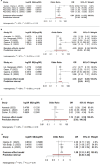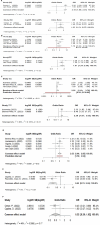Risk factors associated with human Mpox infection: a systematic review and meta-analysis
- PMID: 39900427
- PMCID: PMC11795413
- DOI: 10.1136/bmjgh-2024-016937
Risk factors associated with human Mpox infection: a systematic review and meta-analysis
Abstract
Background: Mpox emerged as a significant global public health concern during the 2022-2023 outbreak, impacting populations in both endemic and non-endemic countries. This study reviews and synthesises evidence on the risk factors associated with human Mpox transmission across these regions.
Methods: A systematic search of peer-reviewed original studies was conducted across Scopus, Embase, Web of Science and PubMed databases, covering publications up to 31 March 2024. The review followed Preferred Reporting Items for Systematic Reviews and Meta-Analyses. Two authors independently screened the articles by title, abstract and full text. The Newcastle-Ottawa Scale used to assess the risk of bias for included articles. Fixed- or random-effects meta-analysis was conducted when at least two studies reported ORs or relative risks, with 95% CIs. Heterogeneity was assessed using the [Formula: see text] statistic. This study was registered on PROSPERO (ID: CRD42023459895).
Results: The systematic review identified 947 articles through database searches, of which 31 met our inclusion criteria. The meta-analysis revealed significant risk factors associated with Mpox infection. Interaction with infected animals (OR=5.61, 95% CI 2.83, 11.13), HIV infection (OR=4.46, 95% CI 3.27, 6.08), other sexually transmitted infections (OR=1.76, 95% CI 1.42, 2.19), unprotected sexual activities (OR=1.53, 95% CI 1.13, 2.07), contact with an infected person (OR=2.39, 95% CI 1.87, 3.05), identification as men who have sex with men (OR=2.18, 95% CI 1.88, 2.51) and having multiple sexual partners (OR=1.61, 95% CI 1.24, 2.09) were associated with increased Mpox infection risk. Conversely, smallpox vaccination was associated with a significantly reduced risk of Mpox infection (OR=0.24, 95% CI 0.11, 0.55).
Conclusion: Identification of risk factors associated with Mpox provides insights for strategic public health planning, enabling targeted interventions for high-risk groups and optimising resource allocation to strengthen Mpox control efforts.
Keywords: Epidemiology; Global Health; Other infection, disease, disorder, or injury; Public Health; Systematic review.
© Author(s) (or their employer(s)) 2025. Re-use permitted under CC BY-NC. No commercial re-use. See rights and permissions. Published by BMJ Group.
Conflict of interest statement
Competing interests: None declared.
Figures



References
-
- WHO . Geneva: World Health Organization; 2022. [10-Aug-2023]. World health organization. multi-country monkeypox outbreak: situation update.https://wwwwhoint/emergencies/disease-outbreak-news/item/2022-DON390 Available. accessed.
Publication types
MeSH terms
LinkOut - more resources
Full Text Sources
Miscellaneous
